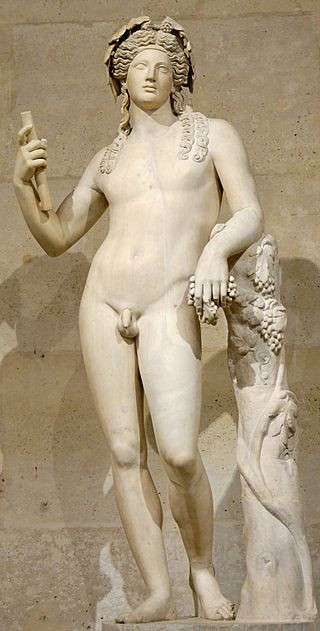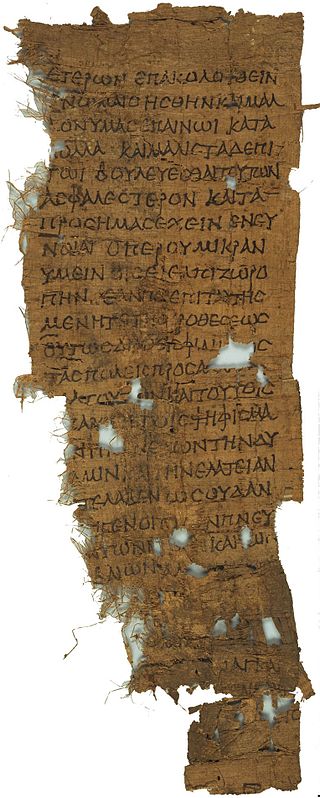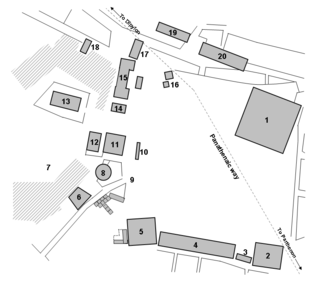Related Research Articles

In ancient Greek religion and mythology, Artemis is the goddess of the hunt, the wilderness, wild animals, nature, vegetation, childbirth, care of children, and chastity. In later times, she was identified with Selene, the personification of the Moon. She was often said to roam the forests and mountains, attended by her entourage of nymphs. The goddess Diana is her Roman equivalent.

In ancient Greek religion and myth, Dionysus is the god of wine-making, orchards and fruit, vegetation, fertility, festivity, insanity, ritual madness, religious ecstasy, and theatre. He was also known as Bacchus by the Greeks for a frenzy he is said to induce called baccheia. As Dionysus Eleutherius, his wine, music, and ecstatic dance free his followers from self-conscious fear and care, and subvert the oppressive restraints of the powerful. His thyrsus, a fennel-stem sceptre, sometimes wound with ivy and dripping with honey, is both a beneficent wand and a weapon used to destroy those who oppose his cult and the freedoms he represents. Those who partake of his mysteries are believed to become possessed and empowered by the god himself.

Erechtheus in Greek mythology was a king of Athens, the founder of the polis and, in his role as god, attached to Poseidon, as "Poseidon Erechtheus". The name Erichthonius is carried by a son of Erechtheus, but Plutarch conflated the two names in the myth of the begetting of Erechtheus.
In ancient Greek religion and mythology, Iacchus was a minor deity, of some cultic importance, particularly at Athens and Eleusis in connection with the Eleusinian mysteries, but without any significant mythology. He perhaps originated as the personification of the ritual exclamation Iacche! cried out during the Eleusinian procession from Athens to Eleusis. He was often identified with Dionysus, perhaps because of the resemblance of the names Iacchus and Bacchus, another name for Dionysus. By various accounts he was a son of Demeter, or a son of Persephone, identical with Dionysus Zagreus, or a son of Dionysus.

In ancient Greek mythology and religion, Selene is the goddess and personification of the Moon. Also known as Mene, she is traditionally the daughter of the Titans Hyperion and Theia, and sister of the sun god Helios and the dawn goddess Eos. She drives her moon chariot across the heavens. Several lovers are attributed to her in various myths, including Zeus, Pan, and the mortal Endymion. In post-classical times, Selene was often identified with Artemis, much as her brother, Helios, was identified with Apollo. Selene and Artemis were also associated with Hecate and all three were regarded as moon and lunar goddesses, but only Selene was regarded as the personification of the Moon itself.
In Greek mythology, the goddess Pandia or Pandeia was a daughter of Zeus and the goddess Selene, the Greek personification of the moon. From the Homeric Hymn to Selene, we have: "Once the Son of Cronos [Zeus] was joined with her [Selene] in love; and she conceived and bare a daughter Pandia, exceeding lovely amongst the deathless gods." An Athenian tradition perhaps made Pandia the wife of Antiochus, the eponymous hero of Antiochis, one of the ten Athenian tribes (phylai).

The Dionysia was a large festival in ancient Athens in honor of the god Dionysus, the central events of which were the theatrical performances of dramatic tragedies and, from 487 BC, comedies. It was the second-most important festival after the Panathenaia. The Dionysia actually consisted of two related festivals, the Rural Dionysia and the City Dionysia, which took place in different parts of the year. They were also an essential part of the Dionysian Mysteries.
The Attic calendar or Athenian calendar is the lunisolar calendar beginning in midsummer with the lunar month of Hekatombaion, in use in ancient Attica, the ancestral territory of the Athenian polis. It is sometimes called the Greek calendar because of Athens's cultural importance, but it is only one of many ancient Greek calendars.
The Lenaia was an annual Athenian festival with a dramatic competition. It was one of the lesser festivals of Athens and Ionia in ancient Greece. The Lenaia took place in Athens in Gamelion, roughly corresponding to January. The festival was in honour of Dionysus Lenaios. There is also evidence the festival also took place in Delphi.
Lycurgus was a statesman and logographer in Ancient Greece. In the aftermath of the Athenian defeat at the Battle of Chaeronea in 338 BC, he became the leading figure in Athenian politics, taking control of Athenian finances and pushing through a range of measures which drastically increased Athens' revenues. This money was used to expand the navy, improve the city's fortifications, develop the temples and religious ceremonies, and to build up a hefty reserve. He also encouraged the restoration of traditional values and prosecuted those who fell short of his expectations of civic behaviour. Because of his leading role, the period from 338 to 324 BC is often known in modern scholarship as the "Age of Lycurgus."

"On the Crown" is the most famous judicial oration of the prominent Athenian statesman and orator Demosthenes, delivered in 330 BC.
The Synoikia was an ancient Greek festival held in Athens commemorating the political unification of Attica. It was also called the Thesean Synoikismos and the Feast of Union, and celebrated Theseus as founder of Athens and the goddess Athena as the city's patron goddess. The festival was celebrated in the month of Hekatombeion on the 16th. A two-day festival, on the 15th and the 16th was held every second year.

The Altar of the Twelve Gods, was an important altar and sanctuary at Athens, located in the northwest corner of the Classical Agora. The Altar was set up by Pisistratus the Younger, during his archonship, in 522/1 BC. It marked the central point from which distances from Athens were measured and was a place of supplication and refuge.

The Sanctuary of Pandion is the name sometimes given to the remains of a building located in the south-east corner of the Acropolis of Athens. Its foundations were found during the excavations for the construction of the Old Acropolis Museum (1865–1874).
The festival calendar of Classical Athens involved the staging of many festivals each year. This includes festivals held in honor of Athena, Dionysus, Apollo, Artemis, Demeter, Persephone, Hermes, and Herakles. Other Athenian festivals were based around family, citizenship, sacrifice, and women. There were at least 120 festival days each year.

Robert Christopher Towneley Parker, FBA is a British ancient historian, specialising in ancient Greek religion and Greek epigraphy.

Christiane Sourvinou-Inwood was a scholar in the field of Ancient Greek religion and a highly influential Hellenist.
Ancient Greek literary sources claim that among the many deities worshipped by a typical Greek city-state, one consistently held unique status as founding patron and protector of the polis, its citizens, governance and territories, as evidenced by the city's founding myth, and by high levels of investment in the deity's temple and civic cult. The temple of the deity involved was usually founded on the highest ground (acropolis) within the city walls, or elsewhere within the central public assembly space, the agora. Conversely, a city's possession of a patron deity was thought to be a mark of the city's status as polis.
Pandion was the eponymous hero of the Attic tribe Pandionis, which was created as part of the tribal reforms of Cleisthenes at the end of the sixth century BC. He is usually assumed to be one of the two legendary kings of Athens, Pandion I or Pandion II.
In Greek mythology, Pandion may refer to the following characters:
References
- Anderson, Greg, The Athenian Experiment: Building an Imagined Political Community in Ancient Attica, 508-490 B.C., University of Michigan Press, 2003. ISBN 9780472113200.
- Bekker, Immanuel, Anecdota Graeca: Lexica Segueriana, Apud G.C. Nauckium, 1814.
- Burkert, Walter, Homo Necans: The Anthropology of Ancient Greek Sacrificial Ritual and Myth, University of California Press, 1983. ISBN 0520036506.
- Canevaro, Mirko, The Documents in the Attic Orators: Laws and Decrees in the Public Speeches of the Demosthenic Corpus, Oxford University Press, 2013. ISBN 9780199668908.
- Cook, Arthur Bernard, Zeus: Zeus, God of the Bright Sky, Volume 1 of Zeus: A Study in Ancient Religion, Biblo and Tannen, 1914.
- Dillon, Matthew, Lynda Garland, Ancient Greece: Social and Historical Documents from Archaic Times to the Death of Alexander, Routledge, 2010. ISBN 9780203854556.
- Demosthenes. Demosthenes with an English translation by A. T. Murray, Ph.D., LL.D. Cambridge, MA, Harvard University Press; London, William Heinemann Ltd. 1939.
- Evelyn-White, Hugh, The Homeric Hymns and Homerica with an English Translation by Hugh G. Evelyn-White. Homeric Hymns. Cambridge, MA.,Harvard University Press; London, William Heinemann Ltd. 1914.
- Harding, Phillip, The Story of Athens: The Fragments of the Local Chronicles of Attika, Routledge, 2007. ISBN 9781134304479.
- Harris, Edward M., Demosthenes, Speeches 20-22, University of Texas Press, 2010. ISBN 9780292794139.
- Kearns, Emily, The Heroes of Attica (Bulletin Supplement 57), University of London Institute of Classical Studies 1989. ISBN 978-0900587603.
- Mikalson, Jon D. (1975), The Sacred and Civil Calendar of the Athenian Year, Princeton University Press. ISBN 0691035458.
- Mikalson, Jon D. (1977), "Religion in the Attic Demes". The American Journal of Philology (The Johns Hopkins University Press) 98 (4): 424–435.
- Parke, Herbert William, Festivals of the Athenians, Cornell University Press, 1977.
- Parker, Robert (1996), Athenian Religion: A History, Oxford University Press. ISBN 0-19-814979-4.
- Parker, Robert (2005), Polytheism and Society at Athens, Oxford University Press. ISBN 978-0-19-927483-3.
- Pickard-Cambridge, Sir arthur W., John Gould and D. M. Lewis, The Dramatic Festivals of Athens Oxford University Press, USA; 2 edition (January 12, 1989). ISBN 0-19-814258-7.
- Robertson, Noel (1991), "Myth, Ritual and Livelihood in Early Greece" in Ancient Economy in Mythology: East and West, ed. M. Silver (Savage, Md. 1991). ISBN 0847676293.
- Robertson, Noel (1993), Festivals and Legends: The Formation of Greek Cities in the Light of Public Ritual, The University of Toronto Press.
- Robertson, Noel (1996), "Athena's Shrines and Festivals" in Worshipping Athena: Panathenaia and Parthenon, The University of Wisconsin Press.
- Roscher, Wilhelm Heinrich, Über Selene und Verwandtes, B. G. Teubner, Leizig 1890.
- Sourvinou-Inwood, Christiane, Tragedy and Athenian Religion, Lexington Books, 2003. ISBN 9780739104002.
- Smith, William; A Dictionary of Greek and Roman Antiquities . William Smith, LLD. William Wayte. G. E. Marindin. Albemarle Street, London. John Murray. 1890. Online version at the Perseus Digital Library.
- Willetts, R. F., Cretan Cults and Festivals, Greenwood Press, 1980. ISBN 9780313220500.